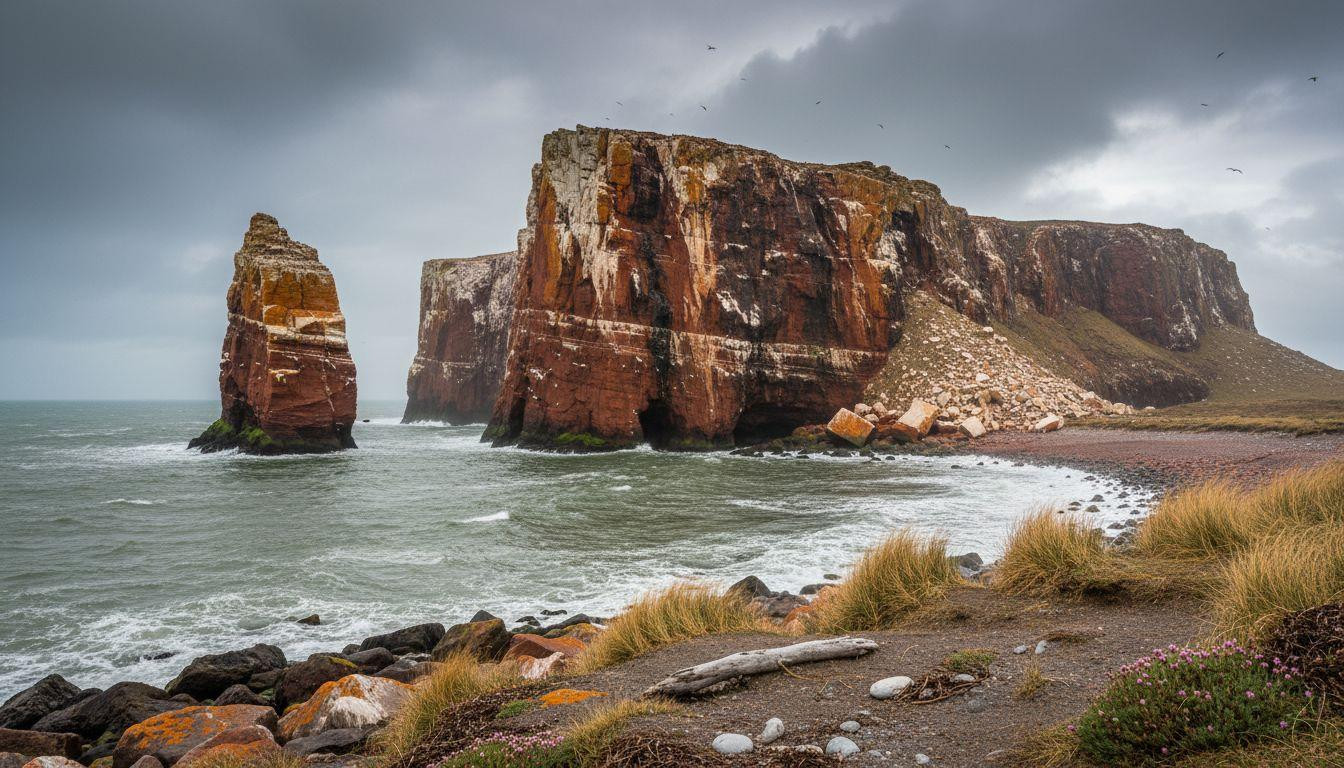Rust-red cliffs pierce through November mist as your ferry cuts across 43 miles of grey North Sea waters. This is Helgoland: Germany’s most remote inhabited island, where 1,300 residents live on ancient red sandstone rising 200 feet from cold waters. While mainland tourists crowd Christmas markets, this forgotten archipelago breathes Europe’s most pollen-free air beneath 10,000 seabirds. The dramatic cliffs glow burnt orange against steel-grey seas, creating Northern Europe’s most unexpected landscape. Here, Britain’s only permanent territorial gift to Germany guards secrets most travelers never discover.
Germany’s only red island sits 43 miles from shore
The ferry from Cuxhaven takes 3.5 hours across open North Sea waters in November. Mainland Germany fades behind as Helgoland’s distinctive red sandstone emerges from the horizon. This unique geology stands alone in a region defined by grey coasts and sandy beaches.
The island measures just 1.6 square miles total, making it one of Europe’s smallest inhabited territories. At 43 miles offshore, it remains Germany’s most remote populated land. The highest point reaches 200 feet above sea level, creating dramatic cliffs that shift from rust to burnt orange with changing light.
November brings moody North Sea weather: wind gusts to 35 mph, mist, and constantly shifting visibility. This isn’t Mediterranean paradise. This is Nordic coastal drama at its most authentic, where Scotland’s white sand dunes feel tropical by comparison.
Where 10,000 seabirds nest on 154-foot red rock
Lange Anna stands as the icon
The 154-foot freestanding red sandstone pillar juts from the northwest tip like a Gothic monument. Originally part of a natural arch until catastrophic collapse in 1860, Lange Anna now stands protected since 1969. Iron oxide in the sedimentary rock catches morning light, turning it burnt orange against grey November skies.
This is Lummenfelsen (guillemot rock) where approximately 10,000 breeding seabird pairs congregate. Guillemots, kittiwakes, razorbills, herring gulls, and gannets create an otherworldly soundscape during breeding season. Even in November, resident seabirds circle the formation, their calls echoing off red cliffs.
Europe’s most pollen-free air surrounds you
The surrounding North Sea provides complete isolation from continental pollen sources. This virtually pollen-free atmosphere creates a literally lighter quality of breathing. Allergy sufferers describe the relief as transformative, breathing freely for the first time in months.
The sensory absence feels as distinctive as any presence. No sneezing, no watery eyes, no congestion. Just pure maritime air mixing salt spray with the particular scent of thousands of nesting seabirds.
Britain’s only permanent gift rebuilt after total destruction
The island that changed hands
Helgoland was British territory from 1807 to 1890, the only land Britain ever permanently ceded to Germany. Germany traded valuable African colonial territories for this tiny North Sea outpost in 1890. This remote island became a German national symbol when poet Hoffmann von Fallersleben composed Germany’s national anthem text here in 1841.
The cultural significance transformed geography into identity. What started as a strategic military position became the birthplace of “Das Lied der Deutschen.” Small coastal communities often carry outsized historical importance.
Devastation and resurrection
The April 1945 RAF thousand-bomber raid was so destructive the island remained uninhabitable for years. British occupation continued until 1952 when control transferred to West Germany. Remarkably, 3,000 West Germans immediately sought to resettle this devastated rock.
Today’s 1,300 inhabitants live on one of Europe’s youngest inhabited landmasses, rebuilt from complete devastation within living memory. The former anti-aircraft control post survives as a working radar installation monitoring North Sea shipping.
What November brings to Germany’s forgotten island
Mid-November 2025 hits the overlooked window when summer crowds vanish but ferries still operate from Cuxhaven. The island becomes genuinely quiet, contemplative rather than commercial. Dramatic North Sea weather and moody skies create atmospheric conditions completely different from summer postcards.
Ferry services run on reduced winter schedules with departures just twice weekly. Accommodation availability opens dramatically with rooms from $95 per night (versus $165 in summer). Grey seals arrive on Düne beaches to molt, creating wildlife observation opportunities without peak-season tourists crowding viewing areas.
The ornithological station continues research work, ringing 15,000 migratory birds annually. Heritage-listed lobster huts along the harbor remain open, serving fresh-caught Helgoland lobster at $38 per dish without summer queues. Remote islands reveal their authentic character when crowds disappear.
Your questions about Helgoland answered
How do I actually get there in November?
Regular ferries depart Cuxhaven twice weekly in November 2025, operated by MS “Helgoland.” The 3.5-hour journey costs $85 round-trip for adults, $200 for families. High-speed catamaran service from Hamburg ends November 2nd. Most visitors stay 2-3 nights rather than day-tripping due to limited ferry schedules and early darkness.
Why is it duty-free?
Helgoland maintains unique duty-free status within Germany, attracting shoppers for discounted spirits and cigars (15-25% below mainland prices). This commercial aspect coexists with natural heritage, creating interesting tension between tourism and preservation. Local tourism boards confirm duty-free shopping accounts for 25% of summer visitors but only 10% in November.
How does it compare to Scottish islands?
Both offer North Atlantic drama, but Helgoland emphasizes geological uniqueness (red sandstone versus grey granite) and extreme isolation. At 43 miles offshore, it feels more intensely isolated than Scotland’s Hebrides with their closer mainland connections. Helgoland packs more dramatic geology into 1.6 square miles than most islands offer across dozens.
By 3:30 PM, November darkness approaches as your return ferry prepares departure. Red cliffs fade into grey mist as Helgoland disappears behind you, looking like a geological mirage that might never have existed. You’ve discovered Europe’s red fortress where 1,300 souls breathe the continent’s purest air, 43 miles from anywhere else.
